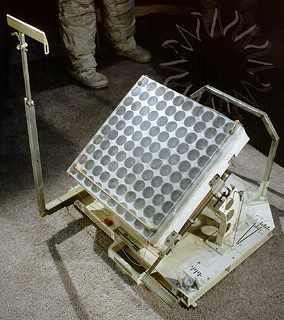Newscientist.com
Why the universe may be teeming with aliens
by David Shiga, 19 November 2008

Similar stories at N.S.
Astrobiology Topic Guide
WANTED: Rocky planet outside of our solar system. Must not be too hot or too cold, but just the right temperature to support life.
It sounds like a simple enough wish list, but finding a planet that fulfils all of these criteria has kept astronomers busy for decades. Until recently, it meant finding a planet in the "Goldilocks zone" - orbiting its star at just the right distance to keep surface water liquid rather than being boiled off or frozen solid.
Now, though, it's becoming increasingly clear that the question of what makes a planet habitable is not as simple as finding it in just the right spot. Many other factors, including a planet's mass, atmosphere, composition and the way it orbits its nearest star, can all influence whether it can sustain liquid water, an essential ingredient for life as we know it. As astronomers explore newly discovered planets and create computer simulations of virtual worlds, they are discovering that water, and life, might exist on all manner of weird worlds where conditions are very different from those on Earth. And that means there could be vastly more habitable planets out there than we thought possible. "It's like science fiction, only better," says Raymond Pierrehumbert, a climate scientist at the University of Chicago, who studies planets inside and outside of our solar system.
Distance from the nearest star is, of course, important. In our own solar system, Venus has long served as an example of what can happen if a planet gets too close to its star. Venus is only 28 per cent closer to the sun than Earth is, but its surface is a sweltering 460 °C, hot enough to melt lead, and it chokes under a thick carbon dioxide atmosphere 90 times the density of Earth's. Put Earth where Venus is and it would probably end up looking rather similar. The extra solar radiation would increase evaporation from the oceans, boosting the amount of water vapour in the atmosphere. As water vapour is a greenhouse gas, this increase would set off a vicious cycle, with higher temperatures triggering more evaporation, until the planet's surface was hot enough to boil away the oceans. At the other extreme, water on a planet that is too far from its star will simply freeze, like on Mars. However, in 1993 a study by James Kasting of Pennsylvania State University, University Park, demonstrated that even in our own solar system, the habitable zone is not based on distance alone. In a calculation based onthe sun's current brightness,
Kasting worked out that while moving Earth just 5 per cent closer to the sun would doom it to the same fate as Venus, it could move almost 1.7 times its current distance from the sun before it would freeze (Icarus, vol 101, p 108). This outer limit is interesting because it is beyond the orbit of Mars, whose orbit has a radius about 1.5 times that of Earth. So if Mars is in our solar system's Goldilocks zone, why isn't it teeming with life? The answer lies in how a planet's mass affects its ability to hold on to a habitable atmosphere. On Earth, the carbon cycle works as a kind of thermostat that keeps the climate liveable. Volcanic activity releases CO2, which warms the Earth's surface via the greenhouse effect, increasing evaporation and rain. The rain erodes carbon-containing minerals from rocks, washing them into the sea. Eventually, these minerals are pulled deep into the Earth in subduction zones.
This balance between emitting and sequestering CO2 has helped keep the Earth's climate stable for the past 4 billion years. Mars, though, is only half the size of Earth, so its interior cooled quickly, shutting down the volcanic activity needed to supply CO2 to the atmosphere. Its weaker gravity also allows its atmosphere to drift away into space. As a result, there is too little CO2 in the Martian atmosphere to warm its surface enough to sustain liquid water. This has probably been the case for much of the past few billion years. Mass, however, is not the only factor. In a series of computer simulations published earlier this year, David Spiegel of Princeton University explored whether factors such as a planet's spin axis or speed of rotation could allow a planet outside of the habitable zone to hold onto liquid water long enough to sustain life (The Astrophysical Journal, vol 681, p 1609).
"I've been kind of twisting the knobs so that they're different from Earth, but they all have the same mass as Earth," says Spiegel, who was at Columbia University in New York when he carried out the work. In some simulations, the team altered the tilt of the planet's spin axis. Earth's axis is tilted 23.5 degrees relative to the plane of its orbit, which is why each hemisphere has longer periods of sunlight during summer and shorter ones during winter. When they gave planets a tilt of 90 degrees, similar to that of the gas giant Uranus in our own solar system, the much larger variations in illumination led to more extreme seasons.
Continued...
___
Top 10: Controversial pieces of evidence for extraterrestrial life
 » Shuttle Endeavour / 2
» Shuttle Endeavour / 2
 NASA turns 50: www.yeeyan.com
NASA turns 50: www.yeeyan.com

 - A cube-corner array of the type deployed by Apollo 11. -
- A cube-corner array of the type deployed by Apollo 11. -  - One of the Laser Ranging Retro-Reflector in place on the Moon. (
- One of the Laser Ranging Retro-Reflector in place on the Moon. (
 »
»  » Union-Tribune:
» Union-Tribune:  » Web:
» Web:  Similar stories at N.S.
Similar stories at N.S. 
 »
»  The Space Shuttle
The Space Shuttle (
(






 » NASA TV:
» NASA TV: 


